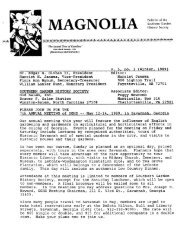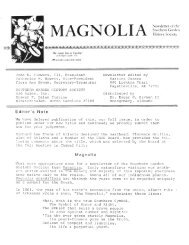Vol. XII, no. 2, 3 & 4 - Southern Garden History Society
Vol. XII, no. 2, 3 & 4 - Southern Garden History Society
Vol. XII, no. 2, 3 & 4 - Southern Garden History Society
Create successful ePaper yourself
Turn your PDF publications into a flip-book with our unique Google optimized e-Paper software.
Sarudy of the Maryland Humanities Council ,<br />
who examined area gardening practices .<br />
Her audience was treated to a series o f<br />
stunning garden/landscape scenes, man y<br />
of which appear in regional furnitur e<br />
decorative schemes .<br />
Despite such an excellent introduction ,<br />
however, neither lectures <strong>no</strong>r slides could do ful l<br />
justice to the gardens and houses scheduled fo r<br />
after<strong>no</strong>on visits. Following lunch at Third Have n<br />
Meeting House — including a gracious<br />
introduction to both the structure and the histor y<br />
of local Friends' meetings — <strong>Society</strong> members<br />
toured a series of sites long connected to th e<br />
Tilghman and Lloyd families . At Hope, a house<br />
of the late eighteenth century built by Peregrine<br />
Tilghman with early twentieth-century gardens<br />
established by William and Ida Starr, we wer e<br />
hosted by current owners, Mr. and Mrs . Pete r<br />
Stifel . Next, Wye Heights, with its early ha-ha<br />
and magnificent array of garden rooms, offere d<br />
a look at the combination of gardens an d<br />
waterscapes that make this area of Marylan d<br />
so interesting .<br />
For those fond of Palladian architectura l<br />
forms as well as early garden sites an d<br />
structures, Wye House then presented a<br />
perfect location to conclude the day . Here<br />
<strong>Society</strong> members <strong>no</strong>t only visited the circ a<br />
1784 dwelling of Edward Lloyd IV, with its awe -<br />
inspiring temple form center block and early<br />
library that included such works as Philip Miller' s<br />
The <strong>Garden</strong>er's Dictionary, but they also were<br />
treated to a close examination of the only<br />
eighteenth-century orangery extant in the country .<br />
Confronting truly omi<strong>no</strong>us weather, Baltimor e<br />
architect Michael Trostel and Mount Ver<strong>no</strong> n<br />
horticulturist Dean Norton then <strong>no</strong>netheless<br />
braved the elements to examine both the Wye<br />
orangery specifically and early green hous e<br />
operations in general . [see Michael Trostel's<br />
article "The Maryland Orangeries" in this issue . ]<br />
Sunday's optional tours treated participants t o<br />
Harleigh, Wye Hall, and Wye Plantation (presently<br />
the location of the Aspen Institute, a <strong>no</strong>n-profi t<br />
educational organization) . +<br />
A Plant List for<br />
the South<br />
by Flora Ann L. Bynum,Winston-Salem ,<br />
North Carolina<br />
"We need a list of heirloom plants for the<br />
South," Peter commented to me this past Marc h<br />
as we traveled together to an herb symposium<br />
in Greensboro, North Carolina, where Peter was<br />
to speak .<br />
"Peter," I said, " that's something I hav e<br />
always wanted to do . We need such a list so<br />
badly. I get constant inquiries in the SGH S<br />
headquarters asking about appropriate plant s<br />
for garden restorations . "<br />
Thus began a discussion on how to go<br />
about achieving such a list . We k<strong>no</strong>w that many<br />
people throughout the South are working on<br />
heirloom plant lists currently . A compilation of<br />
these various lists would be a good first step .<br />
The person sending in a list should b e<br />
responsible for the correct botanical names an d<br />
for supplying background data, such as where<br />
and when the plant was first <strong>no</strong>ted in a<br />
<strong>Southern</strong> garden, <strong>Southern</strong> nursery, or othe r<br />
reference. The lists sent in should be primar y<br />
listing of plants documented for tha t<br />
particular area or site .<br />
A major decision would be how to divide<br />
the various climatic regions of the South ,<br />
which range from the upper <strong>Southern</strong> states ,<br />
to tropical regions of Florida, to the deep<br />
South, and to the western areas of Texas .<br />
We debated whether or <strong>no</strong>t to have a cutoff<br />
date of 1820 and if the lists should only<br />
include plants in common usage, or if<br />
obscure plants should be <strong>no</strong>ted as well.<br />
Although we did <strong>no</strong>t resolve these issues o n<br />
the short ride from my house to Greensboro ,<br />
we are very excited about the usefulness o f<br />
this undertaking . Please send your ideas t o<br />
me at SGHS headquarters . If you have a list<br />
for your area to share, please send it along .<br />
Let us hearfrom you! +<br />
8
















